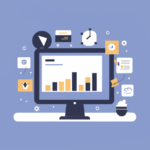In today’s competitive business environment, effective management of your sales process is essential for driving conversions and revenue growth. One powerful framework that has emerged to bridge the gap between strategic planning and operational execution is the sales pipeline funnel. This integrated model combines the granular tracking of individual deals with the broader, conversion-focused perspective of a traditional sales funnel. In this article, we will explore what a sales pipeline funnel is, break down its core components, and discuss practical strategies for optimizing both the pipeline and the funnel aspects to achieve a seamless and efficient sales process.
Defining the Sales Pipeline Funnel
A sales pipeline funnel is an innovative approach that merges the strengths of a sales pipeline and a sales funnel into a unified model. Traditionally, a sales pipeline is used by sales teams to manage and track individual deals, providing detailed insights into the progression of each opportunity—from prospecting and initial contact through to closing. Meanwhile, a sales funnel offers a broader, conceptual view of the customer journey, emphasizing the conversion rates at various stages of the overall lead generation process.
The sales pipeline funnel, therefore, serves as a comprehensive framework that allows businesses to:
- Monitor granular details: Track each deal with precision through defined stages.
- Understand broader conversion dynamics: Visualize how a wide array of prospects are filtered into high-quality leads.
- Integrate data insights: Combine operational data with macro-level conversion metrics to inform strategic decision-making.
By unifying these two models, a sales pipeline funnel provides a holistic view of the sales process, enabling businesses to identify bottlenecks, forecast revenue more accurately, and optimize their overall strategy for better performance.
Core Components of the Sales Pipeline Funnel
To fully leverage the potential of a sales pipeline funnel, it is important to understand its key components. These elements ensure that both the detailed tracking of individual deals and the overall conversion metrics work together seamlessly.
Detailed Deal Stages
At the heart of the pipeline aspect are the specific stages that individual deals pass through. Common stages include:
- Prospecting: Identifying and qualifying potential leads through research and outreach.
- Initial Contact: Making the first connection with prospects to introduce your offerings.
- Needs Assessment: Understanding the prospect’s requirements and challenges through direct communication.
- Proposal: Presenting a tailored solution that addresses the prospect’s needs.
- Negotiation: Engaging in discussions to overcome objections and refine the offer.
- Closing: Finalizing the sale and converting the lead into a customer.
- Post-Sale Follow-Up: Ensuring customer satisfaction and paving the way for future opportunities.
These stages provide granular insights into the sales process, allowing your team to manage follow-ups, prioritize high-value opportunities, and maintain detailed records of each interaction.
Macro-Level Conversion Metrics
Complementing the pipeline, the sales funnel component visualizes the customer journey from a broad perspective:
- Awareness: The point at which prospects first learn about your brand through marketing channels.
- Interest: Prospects engage with your content, expressing curiosity about your offerings.
- Consideration: Potential customers evaluate your solutions, comparing them with alternatives.
- Intent: Leads exhibit buying signals such as requesting demos or more information.
- Conversion: The lead makes a purchase, transitioning into a customer.
- Retention: Ongoing engagement post-sale that fosters repeat business and referrals.
These funnel stages help you measure overall conversion rates and identify at which points prospects drop off, offering strategic insights for optimizing your marketing and sales efforts.
Integrated Data and Analytics
A robust sales pipeline funnel leverages technology to integrate data from both the micro-level pipeline and the macro-level funnel. This integration allows for:
- Real-Time Tracking: Monitoring individual deal progress alongside overall funnel performance.
- Bottleneck Identification: Detecting stages where leads frequently stall or drop out.
- Predictive Analytics: Using historical data and current trends to forecast future revenue and prioritize high-potential leads.
- Unified Reporting: Combining detailed operational data with high-level metrics to provide a comprehensive view of the sales process.
Alignment Between Marketing and Sales
For a sales pipeline funnel to work effectively, it is crucial that both marketing and sales teams work in close alignment:
- Shared Goals: Both teams must be united by common objectives and performance indicators.
- Regular Communication: Feedback loops between marketing (which drives the funnel) and sales (which manages the pipeline) are essential to ensure a seamless transition of leads.
- Coordinated Strategies: Insights from funnel metrics can inform targeted sales actions, while detailed pipeline data can refine broader marketing strategies.
Strategies to Optimize Your Sales Pipeline Funnel
Optimizing a sales pipeline funnel requires a dual focus—enhancing the operational efficiency of your sales pipeline while also improving the conversion rates across the broader funnel. Here are some actionable strategies:
Enhance Data Integration and Technology
Invest in a CRM system that unifies both pipeline and funnel data. Platforms such as Salesforce, HubSpot, or Zoho offer tools to track individual deals while also providing insights into overall conversion trends. The key is to ensure that data flows seamlessly between marketing automation and sales tracking systems, enabling real-time visibility and more informed decision-making.
Improve Lead Qualification and Scoring
Not all leads are created equal. Implement a lead scoring system that evaluates prospects based on engagement, fit, and buying signals. This system should draw on both pipeline details and funnel metrics, ensuring that your sales team focuses on the most promising opportunities. High-quality leads are more likely to progress through the funnel and convert, reducing wasted effort and increasing overall efficiency.
Streamline Sales Processes
Review each stage of your sales pipeline for potential bottlenecks. Whether it’s a delay in follow-up during the initial contact stage or prolonged negotiations, identify where prospects are stalling and take corrective action. Training your sales team on best practices and using automation to handle routine tasks can help accelerate the progression of deals through the pipeline.
Optimize Marketing Strategies
Leverage insights from the sales funnel to refine your marketing approach. If data indicates that a significant number of prospects drop off during the consideration stage, develop targeted content—such as detailed product comparisons, case studies, or customer testimonials—that addresses common concerns. Continuous A/B testing of landing pages, email sequences, and ad creatives can help determine the most effective strategies for driving conversions.
Foster Cross-Functional Collaboration
Regularly schedule meetings between your marketing and sales teams to review funnel performance and pipeline progress. Use these sessions to share insights, adjust strategies, and align on common goals. This collaboration ensures that both teams are working together to optimize the entire sales process, from initial lead capture to final conversion and beyond.
Utilize Predictive Analytics
Advanced analytics can help predict which deals in your pipeline are most likely to close, allowing you to allocate resources effectively. By leveraging historical data and current trends, predictive models can offer actionable insights—such as which stage is causing delays or which leads require immediate follow-up. This proactive approach not only improves forecasting accuracy but also enhances overall pipeline efficiency.
Real-World Applications
Consider a B2B technology firm that integrated its sales pipeline funnel strategy using a leading CRM platform. By analyzing funnel metrics, the marketing team identified that prospects were dropping off during the evaluation stage. In response, they implemented targeted email campaigns with in-depth product demos and customer success stories. Concurrently, the sales team used the detailed pipeline data to prioritize high-scoring leads and streamline follow-up efforts. As a result, the company experienced a 20% increase in conversions and a more predictable revenue stream.
In another example, a retail organization utilized a sales pipeline funnel to manage both online and in-store leads. The integrated system allowed for seamless tracking of prospects from digital engagement to physical store visits. Insights from the funnel highlighted key touchpoints that needed improvement, while pipeline data enabled store managers to personalize interactions with high-potential leads. This dual approach resulted in a 15% reduction in sales cycle time and improved customer satisfaction scores.
Future Trends in Sales Pipeline Funnel Optimization
As technology continues to evolve, the landscape of sales process optimization is set to transform further. Here are some emerging trends that will impact your sales pipeline funnel:
- Artificial Intelligence (AI) and Machine Learning:
AI-driven tools will increasingly automate lead scoring, predict deal outcomes, and offer real-time recommendations for improving funnel performance. - Omnichannel Integration:
Future sales pipeline funnels will seamlessly incorporate data from multiple channels—including social media, mobile apps, and in-store interactions—to provide a unified view of the customer journey. - Enhanced Personalization:
As data collection becomes more sophisticated, businesses will be able to deliver highly personalized experiences throughout the funnel, driving higher engagement and conversion rates. - Interactive Dashboards:
Next-generation analytics platforms will offer interactive dashboards that provide dynamic, real-time insights into both pipeline and funnel metrics, enabling agile adjustments to strategy. - Integration of Virtual and Augmented Reality:
Emerging technologies may create immersive customer experiences that further bridge the gap between digital and physical sales interactions, providing new opportunities to capture and nurture leads.
By staying ahead of these trends, businesses can continually refine their sales pipeline funnel strategy and maintain a competitive edge in an ever-evolving marketplace.
Conclusion
In summary, the sales pipeline funnel is a powerful model that unifies the detailed tracking of individual deals with the broad, conversion-focused perspective of the traditional sales funnel. This integrated approach provides a comprehensive view of the entire sales process—enabling businesses to identify bottlenecks, optimize strategies, and forecast revenue with greater accuracy.
By enhancing data integration, improving lead qualification, streamlining sales processes, and fostering cross-functional collaboration, you can create a robust pipeline funnel that drives efficiency and increases conversions. As technology evolves, embracing predictive analytics and advanced personalization will be key to sustaining success and remaining competitive.
Ultimately, mastering the sales pipeline funnel empowers your organization to transform raw leads into loyal customers through a data-driven, unified sales process. With continuous optimization and a strategic focus on both the macro and micro elements of your sales journey, your business can achieve remarkable growth and long-term success.



